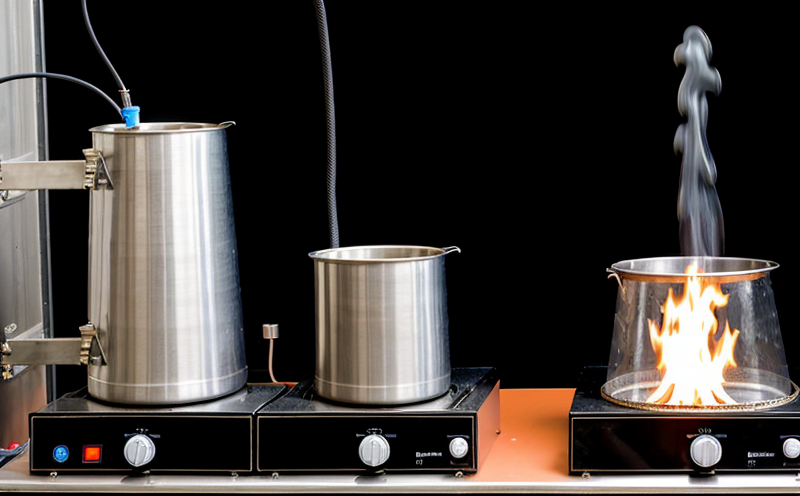Calorimetric Analysis of Textile and Fabrics
The process of calorimetric analysis of textiles involves measuring the heat released during combustion. This analysis is critical for ensuring materials used in various industries meet fire safety standards, as it helps determine how much heat a material will release when exposed to flame. This information is vital for predicting the potential hazard posed by fabrics and textiles in real-world scenarios.
Calorimetric testing can be performed using different calorimeters depending on the requirements of the test and the specific application. Common methods include Cone Calorimeter tests, Oxygen Consumption Calorimeters (OCC), and Large Flame Calorimeters (LFC). Each method is designed to simulate real-world fire conditions while providing precise data on heat release rates.
During calorimetric testing, textile samples are subjected to controlled combustion in a calorimeter. The amount of heat released during the combustion process is measured and compared against standards set by organizations such as ISO (International Organization for Standardization) and ASTM International. These standards ensure that all tests are conducted under consistent conditions, allowing for accurate comparisons between different materials.
The results from calorimetric testing provide valuable insights into a fabric's flammability characteristics. By understanding how much heat is released during combustion, manufacturers can make informed decisions about material selection and design changes to improve fire safety. For example, if a particular textile releases too much heat upon ignition, modifications may be made to its composition or manufacturing process to reduce this risk.
It's important to note that calorimetric analysis is not just limited to fabric production; it also plays a crucial role in end-of-life considerations for textiles. Knowing how fabrics behave when exposed to fire can help determine their recyclability and sustainability potential. Additionally, the data obtained from these tests contributes significantly to developing safer products across various sectors including automotive, aerospace, furniture, and more.
Manufacturers must comply with strict regulations regarding flammability in order to market their products safely. Calorimetric testing ensures compliance by providing objective evidence about a material's performance under fire conditions. This process helps protect consumers from potentially dangerous situations while promoting safer product designs.
The importance of accurate calorimetric analysis cannot be overstated, especially given the increasing demand for sustainable and environmentally friendly materials in today’s marketplaces. By leveraging this technology early on in the development stage, companies can ensure they are meeting both regulatory requirements and consumer expectations regarding safety and sustainability.
- Compliance with international standards such as ISO 13542-1 for Cone Calorimeter tests ensures consistency across different laboratories worldwide.
- OCC testing provides valuable insights into the oxygen consumption of fabrics, which is essential for understanding their contribution to fire behavior.
Industry Applications
The application of calorimetric analysis extends beyond just fabric production; it has significant implications across multiple industries where textiles play a key role. Automotive manufacturers, for instance, rely heavily on flame retardants and other fire-resistant additives to protect passengers in the event of an accident. By conducting calorimetric tests during the design phase, they can ensure that their materials meet stringent safety standards.
In aerospace applications, where weight is a critical factor, selecting appropriate fire-resistant textiles becomes even more challenging. Calorimetric analysis allows engineers to evaluate different materials based on their heat release properties without sacrificing structural integrity or performance capabilities. This ensures that the chosen fabrics contribute positively towards overall aircraft safety without adding unnecessary bulk.
The furniture industry also benefits greatly from calorimetric testing as it helps identify suitable upholstery options for high-traffic areas within buildings. Knowing how much heat a material will generate upon ignition allows designers to select products that not only look good but are also safe for public use. Moreover, this information aids in designing fire-resistant seating arrangements which could save lives during emergencies.
For apparel manufacturers, calorimetric analysis ensures that clothing items comply with relevant regulations concerning flammability limits. This is particularly important for children’s wear where strict guidelines exist to prevent burns or other injuries resulting from accidental ignition. By incorporating accurate data obtained through calorimetry into their product specifications, companies can offer safer garments while maintaining aesthetic appeal.
The construction sector similarly uses calorimetric analysis when specifying interior finishes and insulation materials used in building structures. Understanding how these components interact with fire is crucial for creating safe environments that meet local codes and standards. The data gathered from such tests informs decisions about which products should be specified, thereby enhancing occupant safety.
International Acceptance and Recognition
Calorimetric analysis of textiles is widely recognized globally for its role in ensuring fire safety across various industries. International organizations like ISO have established comprehensive guidelines that govern the conduct of these tests, promoting consistency and reliability among different labs worldwide.
The ISO 13546 series provides detailed procedures for conducting calorimetric testing on textiles using Large Flame Calorimeters (LFCs). These standards outline specific protocols for sample preparation, test setup, data collection, and interpretation. Adherence to these guidelines ensures that results are comparable between laboratories regardless of their location or equipment used.
Similarly, ASTM International offers similar specifications through its E1352 standard which focuses on the use of Oxygen Consumption Calorimeters (OCCs). This standard emphasizes accurate measurement techniques aimed at assessing the flammability characteristics of textiles in controlled environments. Both ISO and ASTM standards are widely accepted by regulatory bodies around the world making them crucial references for industry professionals.
Recognition from these organizations underscores the importance placed on calorimetric analysis within the broader context of fire safety research and development efforts. By aligning with established international norms, laboratories demonstrate their commitment to delivering high-quality results that contribute meaningfully towards improving public safety standards globally.





